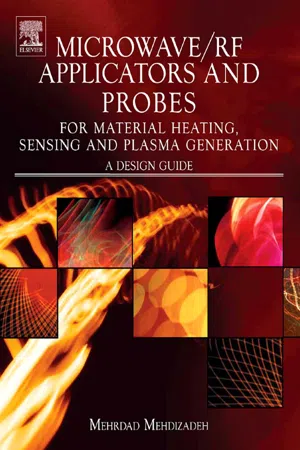1.1.1 The wave equations and materials
The essential role of material properties in electromagnetics is readily evident in two of the four Maxwell equations that govern the relationships between electric field vector
and magnetic field vector
:
The three basic material properties σ, ε, and μ are called conductivity, permittivity, and permeability respectively. The above two equations, which are called Ampere’s law and Faraday’s law, relate time variations of one field to spatial variations of the other. In other words, they state that time-varying electric fields induce magnetic fields, and time-varying magnetic fields induce electric fields. The only exception to time-varying requirement is the term in Eq. (1.1), which means in the presence of mobile electric charges (free electrons in conductors), even a non-time-varying electric field can give rise to a magnetic field. This principle is the basis of all direct current (DC) electricity. The converse, however, is not true. Since there are no known magnetic charges, a time-varying electric field cannot exist without an accompanying magnetic field.
Further examination of Ampere’s and Faraday’s laws suggests that the ratio between the intensities of electric magnetic fields in time and space are set by surrounding material properties. Even a vacuum has permittivity and permeability, but not conductivity, since there are no free charges in a vacuum.
The subject of applicators and probes covered in this book is considered using steady-state time-varying systems throughout, which means the time variations of fields as shown in the right-hand sides of Eqs (1.1) and (1.2) are sinusoidal. This fact greatly simplifies relationships between electric and magnetic fields in steady-state systems. Instead of instantaneous values of fields, only the amplitudes of the fields along with the operating frequency need to be considered. In steady state, Eqs (1.1) and (1.2) become:
where at the operating frequency
f (in Hz),
ω = 2
πf is the angular frequency and
is the complex operator. For the rest of this book, unless stated otherwise, the electric field and magnetic fields mentioned are either magnitudes of the steady-state values, or the root mean square (RMS) value, which is a time average of a sine wave.
For solving practical problems involving boundary conditions, combining Eqs (1.3) and (1.4) yields the wave equations in phasor form [5]:
where the operator is called Laplacian, and k is the wave number where:
The angular frequency is ω = 2πf in radians/second (rad/s) and f is the operating frequency in Hz. Note that permittivity, ε in farads/meter (F/m), and magnetic permeability, μ in henries/meter (H/m), in general, are complex quantities, as we will examine later. Their values in free space, however, are ε 0 = 8.85 × 10−12 F/m and μ 0 = 4π × 10−7 H/m.
The wave equations (1.5) and (1.6) are better suited for solving practical boundary value problems such as those in appl...











